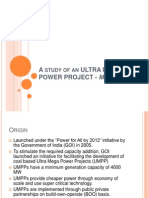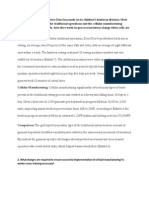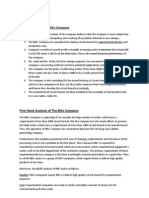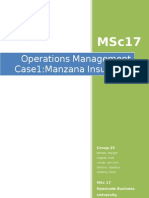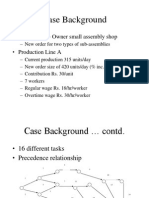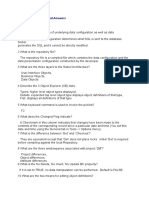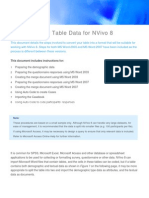Write Up - Case Study - Donner Company
Write Up - Case Study - Donner Company
Uploaded by
Ganesh AroteCopyright:
Available Formats
Write Up - Case Study - Donner Company
Write Up - Case Study - Donner Company
Uploaded by
Ganesh AroteOriginal Title
Copyright
Available Formats
Share this document
Did you find this document useful?
Is this content inappropriate?
Copyright:
Available Formats
Write Up - Case Study - Donner Company
Write Up - Case Study - Donner Company
Uploaded by
Ganesh AroteCopyright:
Available Formats
PGP-1 IIM-Indore Batch 2010-12
Case Study Operations Management-I Donner Company
Group 1 Sec A
Faculty: S. Venkat
Group Members: Ashutosh Shukla Ashu Tomar Anupama Sharma Atul Bodke Prabhanshu Uchhana Praveen Kumar P Sandeep Shekhar Swapnil karande
Donner Company Established in 1985 by Edward Plummer, is one of the leading manufacturers of Printed Circuit Boards for experimental devices and for pilot production runs. The company leadership boast of superior skills in anticipating and resolving the problems that might occur while designing and manufacturing prototypes of new/experimental products. Problem: 1) Different modules of the plants are situated very far from each other in order to not let one module get affected by another. 2) Rush orders and reworks keep the assembly lines busy and create bottlenecks for the daily manufactures. 3) Quality checks are not stringent. 4) Workers and processes are not managed properly and to the fullest of their potential. Cause: 1) Modules are situated far from each other because a certain processes emit certain fumes that will add to the wear and tear of the machinery. Since the company has taken loan amounts and invested in purchasing the quality machinery, the management wants the machinery to be used to its fullest potential and is reluctant to expose machinery to harmful fumes. Also some of the machining operations that exhausted dust and dirt had to be separated from some of the manufacturing modules like imaging, plating and etching processes as these modules were sensitive to the dust. The acid vapours and the dirt & dust combined has resulted in situating machinery far from each other which has resulted in employees spending 15% of their time in just moving from one place to another. 2) Company has only one assembly line at its disposal and therefore has to share it between the daily manufactures, Rush orders, reworks, etc. It has been observed by Mr. Plummer while assessing the companys operating position that forecasting on which day and at what time will the rework jobs and rush orders will be creating pileups in the assembly line. This is mainly because the amount of workload put on the assembly line by these individual orders is different on each operation, resulting into no of bottlenecks being created where output rate of one module exceeded input rate of the next module. Since there is no way to predict such instances, Mr. Flaherty, the supervisor, had found it extremely difficult to compensate for these variations. 3) Another major problem the company is facing is its quality standards. The company has been marred by the high rate of reworks that it was receiving. In September the companys rejection rate was amounted to be 7%. It was observed that in past few months only 10% of the rejected boards were because of the damage to the boards and/or out of tolerance. The remaining 90% of the rework was due to incomplete operations performed on them. This is an area of concern. We already have a no of instances where reworks are creating problems in the assembly line; The Company needs to make sure that the operations done on the Printed Circuit Boards is proper so that the no of reworks is reduced by 90%.
4) Workers are not managed properly; many of the workers employed in the company are multi-skilled. These workers are expected to do work in multiple modules as per required and most of the time the requirements are on adhoc basis. There have been instances in the company a few days back where lack of proper structure in the organisation hierarchy has led to unnecessary problems arising which could have been avoided otherwise. E.g. there was no work in manual drilling department in the morning so the workers were asked to transfer to other department and by noon no of expedited offers reached the drilling operation but that time all the three workers were busy in some other tasks. These kinds of instances are classic examples of mismanagement of the employees. Apart from the employees, some of the operations are also not managed properly to their fullest extent. E.g. a lot of time is wasted in negotiating deals with vendors for procuring raw materials every time an order is placed. The purchasing agent requires one or two days to negotiate and procure the raw material at the lowest price available in the market. Adding to it the time to log and create blueprints; the orders were actually reaching Flaherty, who is the Supervisor, about four days after the order was accepted by the company. Although the amount of work that the company is receiving is varying, it is still not the most feasible practice to keep repeating the task of negotiations and procurement of raw materials on individual order basis. This is resulting in loss of precious time. probable solutions: 1) Hire unskilled workers to perform the menial tasks of transferring unfinished boards from one module to another. 2) Have a tentative flexible plan as to when and for how much time is the assembly line is going to be used by various orders. Not just merely on the priority basis (Rush order first) but also on the availability basis. (Further explained in solutions segment) 3) Have an extra department directly under one of the senior managers which will deal with the quality checks of the raw materials and also the finished products. 4) Have a definite organisation structure which will define every employees area of expertise and assign them to that particular operational module only. Disband any adhoc changes to the organisation structure on an intra-day basis. Since the amount of work that comes is unpredictable, the company can have the organisation charts on weekly basis which will define in which operation module is any particular employee supposed to contribute on which particular given day. 5) Create relationships with a vendor or a group of vendor and establish a loyal connection in between the company and the vendor(s). 6) Shift the machinery of the different modules closer and create insulating barriers between them so that the fumes and the dust particles are not transferred to other modules. Also availability of small objects like exhaust fans in each insulated sections will be helpful in banishing the acidic fumes, dust and dirt away from machinery.
7) Have battery driven carts or a conveyer belt to transfer the objects from one module to another. Since 15% of the employees time is spend in this kind of work, it will be helpful to automate this particular part of transferring objects. 8) Procure some extra machinery for creating an auxiliary assembly line especially at the places where most no of bottlenecks has been observed. This will remove the problems that are created by the reworks and rush orders for the manufacturing of the daily orders. Solution: WHY NOT? 1) We cannot go for moving the machinery as some of the equipments like the 20-ton punch press are very heavy. The restructuring of the manufacturing floor like adding insulating walls and exhaust fans etc in addition to moving heavy machinery, will not only require a lot of investment in context with both time and money, but might also lead to shutting down of the plant for around 2-3 weeks time. This will have a very negative impact on the companys productivity and profits. 2) The option of having battery driven carts or conveyer belts has similar disadvantage as that of the previous alternative. This alternative also requires a lot of investment and will also add to the maintenance costs of the company. 3) Procuring extra machinery is out of the question, as the company has already taken loans from banks to pay for the expensive machinery involved in the manufacturing process. The company simply cannot afford to go more deep into debt to purchase an extra set of machinery just to avoid intermittent bottlenecks. This solution however seems the most feasible one at the time in the future when company is able to make huge profits and has paid most of the debt. This alternative should be freeze by the company for plans of any further expansions in the future that might occur. WHY YES? The company should go with the following combination of the alternatives to resolve the problems its facing now. 1) The company needs to hire unskilled workers to move the unfinished printed circuit boards in small batches to the next modules transferring that are taking as high as 15% of their time in moving from one place to another. The unskilled workers thus will perform the tasks similar to an office-boy. The batch size of the printed circuit boards that are moved by the workers at one time will be directly proportional to the distance between two consecutive modules. These workers will not require high investments to start with and also the costs related with them will be pretty low as the salaries of unskilled workers are not very high. 2) Having a tentative plan will help company make use of the assembly line more efficiently than how they are using now. According to the current plan the rush orders get first preference and then the reworks and normal daily manufactures. According to new plan of action, we will keep the assembly line usage on an adhoc basis. In this way if a rush order is
operational in such a way that it is leaving a few modules without considerable amount of work, The daily manufactures or the reworks can immediately take the opportunity to use that particular operations. In case any one of the rush orders require the module then again the rework, daily manufactures will go on standby and then wait for the module to be free again. a. Here the Advantage is that the bottlenecks created due to rush orders will be reduced if not completely removed and also the efficiency of the workers will increase as at no point of time any worker in any module will remain without work. b. On other hand the Disadvantage of this approach is that there will be a lot of unfinished printed circuit boards from the reworks and daily manufactures waiting at almost every module. However, this disadvantage loses its value as it is already known that the company does not have any restraints as far as the space is concerned. Therefore storing these unfinished boards and bringing them back to the assembly line will not create any problems as we have already hired unskilled help to do such tasks only. 3) Following point 2 of the solution will ensure that there are no employees unassigned to any work. This will make need to change departments of the employees sparse. However, Its still recommended for the company to have a definite organisation structure. This need not be as rigid as some of the big-scale companies which have thousands of employees at their disposal. The organisational structure can be revamped every week or so according to the volume of the work that the company is having. Forecasting for mere week will be easier and it will also bring more organised feel to the employees. 4) Its been mentioned that having a structured plan or a checklist will not be feasible to raise the quality standards as the expectations of the customers differ from order to order. The only other solution is to have a small section of about 2-3 people max. Who will be able to go through the raw materials and finished Printed Circuit boards to check whether any specifications have been met or not. Here Mr. Altmeyer will be most suited man for the job as he is the one who inspects the customers artwork and requirements in order to locate any possible errors in design. This process done at the start of the manufacturing process will enable him to be aware of the exact requirements and therefore he will be the best judge of whether the manufactured printed circuit board is perfect to be delivered or not. 5) To ensure quality and to reduce the number of rejects, a job-card with quality checklists can be created at the time of design and circulated along with the batch. The job-card will include information like what are the expectations at the end of each module. Also to avoid the quality problems arising out of missed operations on a PCB, Instead of having only one master blueprint with Mr. Flaherty, Blueprints extra copy needs to be circulated along with the job card. When blueprint is accessible to the workers, they can know whether any operations are missed or not. 6) The last but not the least point that the company needs to look into is their relationships with their raw material vendors. Its been observed that no amount of raw material is stored before hand by the company and every time an order is placed the purchasing agent has to
negotiate the best deal available in the market and procure raw material. This process takes almost 2 days, which is a big amount of time to be wasted on a trivial thing that can be avoided. Some of the points to note here are that the raw materials that are used are not the kinds which get expired easily. E.g. copper, acid, solder etc. Also as per the exhibit 4 the most commonly used base stocks like A,B,D,M,etc. Should be buffered. Even though the company is unable to forecast as to how many orders will be placed at what point in time, it is advisable to the company to keep at least some amount of raw materials buffered. The amount can be just enough to start processing the order with. During which time more raw materials can be procured as per requirement of the customer. This brings us to the second part of this point. Having a fixed vendor to provide the necessary raw materials to the company will help in reducing the amount of time that is required to negotiate and procure the goods. It is advisable that the company makes one time negotiations with the vendor. Signing mutual contracts of doing business with the vendor and vendor providing the raw materials faster than others in market will help both the parties in this endeavour. Also the Donner Company can expect some amount of discounts from the vendor on the basis of loyalty to that vendor. This will help the Company remove delays in procuring raw materials and the saved 2 days time period will add to the buffer time for completing the manufacturing process. This approach provides a two way advantage of easy access to the raw materials and more buffer time to solve bottlenecks and still deliver on time. 7) Expertise of Arthur Dief should be utilized by training other senior employees under him, also lessons from his timely and high quality work be used as input in resource scheduling. 8) For the operations like drilling and profiling there is an option of performing the operations on CNC machines. But CNC machines are preferable only if the no of circuit boards is greater than 6 for drilling and for profiling around 200. We create such similar rules for all the modules and take them into consideration during the scheduling of the batch.
You might also like
- OM - Case - Analysis - Donner Company Case ReportDocument8 pagesOM - Case - Analysis - Donner Company Case Reportpusparghya pakrasiNo ratings yet
- Major Airlines Would Like To Train New Flight Attendants inDocument1 pageMajor Airlines Would Like To Train New Flight Attendants inAmit PandeyNo ratings yet
- Group 1 Donner Company CaseDocument7 pagesGroup 1 Donner Company CaseAjay Kumar100% (1)
- A) What Are The Information Flows Within The Donner Factory. Trace An Order As It Moves From The Originating Customer To CompletionDocument6 pagesA) What Are The Information Flows Within The Donner Factory. Trace An Order As It Moves From The Originating Customer To CompletionAKRITI GUPTANo ratings yet
- Operations Research Assignment Sheet 1Document2 pagesOperations Research Assignment Sheet 1praveen_bpgcNo ratings yet
- Manzana Case AssignmentDocument5 pagesManzana Case AssignmentVineshNo ratings yet
- Cost Accounting AssignmentDocument6 pagesCost Accounting AssignmentRamalu Dinesh ReddyNo ratings yet
- SalesDocument3 pagesSalesEdgardo MartinezNo ratings yet
- AIC Netbooks Optimizing Product AssemblyDocument2 pagesAIC Netbooks Optimizing Product AssemblyPedro José ZapataNo ratings yet
- Final PPT UmppDocument13 pagesFinal PPT UmppDhritiman PanigrahiNo ratings yet
- Donner Process FlowDocument1 pageDonner Process FlowzindalonerNo ratings yet
- Donner Case StudyDocument35 pagesDonner Case Studyaaaa0408100% (2)
- POWER Transients in Power Systems 217 P PDFDocument217 pagesPOWER Transients in Power Systems 217 P PDF19848096No ratings yet
- Gartner Hype Cycle For IO-AO AutomationDocument60 pagesGartner Hype Cycle For IO-AO Automationraja2jaya100% (3)
- Group 8 - Donner SolutionDocument4 pagesGroup 8 - Donner SolutionMayank MishraNo ratings yet
- What Changes Are Required To Ensure Successful Implementation of Cellular Manufacturing? Is Worker Cross-Training Necessary?Document4 pagesWhat Changes Are Required To Ensure Successful Implementation of Cellular Manufacturing? Is Worker Cross-Training Necessary?isaavedracastroNo ratings yet
- Blitz Process FlowDocument6 pagesBlitz Process FlowPrashant DhayalNo ratings yet
- Group 2 Michigan Manufacturing CorporationDocument22 pagesGroup 2 Michigan Manufacturing CorporationtheplacementcircleNo ratings yet
- Manzana Insurance: The Business ProblemDocument8 pagesManzana Insurance: The Business ProblemDeepti AgarwalNo ratings yet
- Manzana IntroDocument5 pagesManzana IntroSnehil RajNo ratings yet
- AssgmintDocument4 pagesAssgmintArooj HectorNo ratings yet
- BCE: INC Case AnalysisDocument6 pagesBCE: INC Case AnalysisShuja Ur RahmanNo ratings yet
- Manzana Insurance Fruitvale Branch - Group 6Document10 pagesManzana Insurance Fruitvale Branch - Group 6Puneet AgarwalNo ratings yet
- Manzana Insurance: The Business ProblemDocument8 pagesManzana Insurance: The Business Problemdhirendra katiyarNo ratings yet
- Report Manzana RenzDocument12 pagesReport Manzana RenzMarcel FennisNo ratings yet
- Nypro IncDocument13 pagesNypro IncRendy Fadhlan PutraNo ratings yet
- Prestige Telephone CompanyDocument2 pagesPrestige Telephone CompanyArbaz AbbasNo ratings yet
- Manzana Insurance: A Case Analysis OnDocument8 pagesManzana Insurance: A Case Analysis OnsksNo ratings yet
- Case Background: - Mrs. Santha - Owner Small Assembly Shop - Production Line ADocument12 pagesCase Background: - Mrs. Santha - Owner Small Assembly Shop - Production Line AAbhishek KumarNo ratings yet
- Sealed Air Case QuestionsDocument1 pageSealed Air Case QuestionsHimanshu ChauhanNo ratings yet
- Interesting Cases HbsDocument12 pagesInteresting Cases Hbshus2020No ratings yet
- Amerbran CompanyDocument1 pageAmerbran CompanySakshi Yadav100% (1)
- Decision Report On Technotronics 1979: MemorandumDocument9 pagesDecision Report On Technotronics 1979: MemorandumKandarp PandeNo ratings yet
- Mos GameDocument13 pagesMos GameMahendra SharmaNo ratings yet
- Anu - Shrivastava & Vinay - Kumar - B - WACII - 1Document8 pagesAnu - Shrivastava & Vinay - Kumar - B - WACII - 1VinayNo ratings yet
- 05 Lilac Flour MillsDocument6 pages05 Lilac Flour Millsspaw1108No ratings yet
- SecA Group8 CaseMichiganManufacturingCorpDocument7 pagesSecA Group8 CaseMichiganManufacturingCorpSuyash LoiwalNo ratings yet
- Manzana-Class 6 - Capacity IV and CEMDocument22 pagesManzana-Class 6 - Capacity IV and CEMSateesh HegdeNo ratings yet
- Operations Management: Analysis of A Service ProcessDocument14 pagesOperations Management: Analysis of A Service ProcessNitu PathakNo ratings yet
- Donner CompanyDocument4 pagesDonner CompanyFrancesco BrunoNo ratings yet
- Is Aqualisa Quartz A Good Product? Why?Document5 pagesIs Aqualisa Quartz A Good Product? Why?Sirsha PattanayakNo ratings yet
- Atlantic Bundle Case Study - Group M2Document6 pagesAtlantic Bundle Case Study - Group M2ShivaniNo ratings yet
- Operations Management - Group 7 - Sec B - Manzana InsuranceDocument9 pagesOperations Management - Group 7 - Sec B - Manzana InsuranceVivekMandalNo ratings yet
- ISM Case Analysis (Cisco Systems) : Group 13 Section - ADocument6 pagesISM Case Analysis (Cisco Systems) : Group 13 Section - AManish Kumar BansalNo ratings yet
- Assignment 1: Sands Corporation A Report Submitted To Prof. Danesh GojerDocument10 pagesAssignment 1: Sands Corporation A Report Submitted To Prof. Danesh GojerrutulNo ratings yet
- Delays at Logan Group B3Document20 pagesDelays at Logan Group B3Shubham Agnihotri100% (1)
- Manzana AnswersDocument2 pagesManzana AnswersAlbert LeeNo ratings yet
- Q.1What Is The Competitive Priorities For Synthite?: Input DataDocument4 pagesQ.1What Is The Competitive Priorities For Synthite?: Input DatarakeshNo ratings yet
- Hank Kolb Case SolutionDocument7 pagesHank Kolb Case SolutionAbhishek PalNo ratings yet
- Assignment Iii Mansa Building Case Study: Submitted by Group IVDocument14 pagesAssignment Iii Mansa Building Case Study: Submitted by Group IVHeena TejwaniNo ratings yet
- Manzana Insurance CaseDocument5 pagesManzana Insurance CaseSethNo ratings yet
- SectionA Group8 Manzana InsuranceDocument19 pagesSectionA Group8 Manzana Insurancekarthikmaddula007_66No ratings yet
- Pros of Vega Information Systems:: Assignment 4: The Decision DilemmaDocument3 pagesPros of Vega Information Systems:: Assignment 4: The Decision DilemmaSam SamNo ratings yet
- Prestige Telephone CompanyDocument9 pagesPrestige Telephone CompanyVikasDalalNo ratings yet
- Midterm Practice 2: Machining On A Machining On B Machining On CDocument3 pagesMidterm Practice 2: Machining On A Machining On B Machining On CraymondNo ratings yet
- AIC NetbooksDocument2 pagesAIC NetbooksSriharsha VavilalaNo ratings yet
- GE AnswerDocument2 pagesGE AnswerThanshali NarzaryNo ratings yet
- Donner Case Study - MBA 621 PDFDocument35 pagesDonner Case Study - MBA 621 PDFViswateja KrottapalliNo ratings yet
- Donner Case Study - MBA 621Document37 pagesDonner Case Study - MBA 621varunragav85No ratings yet
- Group C MIDTERM ACTIVITY 1 Case Study Electroplus IncorporatedDocument5 pagesGroup C MIDTERM ACTIVITY 1 Case Study Electroplus Incorporatedkookie bunnyNo ratings yet
- Takt Time: A Guide to the Very Basic Lean CalculationFrom EverandTakt Time: A Guide to the Very Basic Lean CalculationRating: 5 out of 5 stars5/5 (2)
- Creating a One-Piece Flow and Production Cell: Just-in-time Production with Toyota’s Single Piece FlowFrom EverandCreating a One-Piece Flow and Production Cell: Just-in-time Production with Toyota’s Single Piece FlowRating: 4 out of 5 stars4/5 (1)
- India Since IndependenceDocument1 pageIndia Since IndependenceGanesh AroteNo ratings yet
- Nature and ScopeDocument5 pagesNature and ScopeGanesh AroteNo ratings yet
- Cost of Capital ReviewDocument7 pagesCost of Capital ReviewGanesh AroteNo ratings yet
- Airthread WorksheetDocument21 pagesAirthread Worksheetabhikothari3085% (13)
- Assignment TemplateDocument8 pagesAssignment TemplateGanesh AroteNo ratings yet
- ChileDocument2 pagesChileGanesh AroteNo ratings yet
- Write Up - Case Study - Donner CompanyDocument6 pagesWrite Up - Case Study - Donner CompanyGanesh AroteNo ratings yet
- Cam Based Sand FilterDocument56 pagesCam Based Sand FilterANAND KRISHNAN100% (1)
- Inventory MGT Zuari Cement 2010Document65 pagesInventory MGT Zuari Cement 2010Ghule VinayakNo ratings yet
- Analytical Report For Ketofast 10 TabletDocument20 pagesAnalytical Report For Ketofast 10 TabletShagorShagorNo ratings yet
- Installation & Testing of Above Ground Drainage PipingDocument6 pagesInstallation & Testing of Above Ground Drainage PipingmohamedsyedaliNo ratings yet
- RailwayDocument111 pagesRailwayshymaa elbakryNo ratings yet
- Hover Flight Helicopter Modelling and Vibrations Analysis PDFDocument8 pagesHover Flight Helicopter Modelling and Vibrations Analysis PDFselinNo ratings yet
- Quiz 02Document6 pagesQuiz 02bbbbbNo ratings yet
- CVDocument4 pagesCVAbu BiduNo ratings yet
- Chapter 2: Entity-Relationship ModelDocument42 pagesChapter 2: Entity-Relationship Modelrosev15No ratings yet
- Questa - Questions and AnswersDocument48 pagesQuesta - Questions and AnswersChiranjeevi ChNo ratings yet
- NOR-NAWD-LAWD - Iom Walk in CoolerDocument87 pagesNOR-NAWD-LAWD - Iom Walk in Coolermisaeldominguez1992No ratings yet
- Sop 001 KCMCDocument7 pagesSop 001 KCMCAsaad ChughtaiNo ratings yet
- Rupture Disc Main PDFDocument4 pagesRupture Disc Main PDFdumpuuNo ratings yet
- RG 05 Rev 01 - List of Conformity Assessment Activities and Mandatory ScopesDocument4 pagesRG 05 Rev 01 - List of Conformity Assessment Activities and Mandatory ScopesAnonymous G6ceYCzwtNo ratings yet
- ISTQB Mock Exam 3Document9 pagesISTQB Mock Exam 3Andrei NăstăsoiuNo ratings yet
- ML 2150A Laser Welders Manual Rev JDocument166 pagesML 2150A Laser Welders Manual Rev JRick ChenNo ratings yet
- Amhara Water Works Construction Enterprise Level 3Document4 pagesAmhara Water Works Construction Enterprise Level 3Ze DagimNo ratings yet
- Case 3MDocument7 pagesCase 3MHey Ma SNo ratings yet
- 11 Atlas Copco MAI Self DrillingDocument2 pages11 Atlas Copco MAI Self Drillingveni jesiaNo ratings yet
- Preparing Your Table Data For NVivo 8Document11 pagesPreparing Your Table Data For NVivo 8Nathan ChihomboriNo ratings yet
- History of Aviation Lec 1Document25 pagesHistory of Aviation Lec 1aahsan345No ratings yet
- Hris PrintDocument9 pagesHris PrintAdhil MujeebNo ratings yet
- PILZ - Safety Compendium (2012)Document298 pagesPILZ - Safety Compendium (2012)Jorge_Andril_5370100% (1)
- Jigs and Fixtures Design PTB41002: Cost Calculation Raja Aziz Raja Ma'arofDocument18 pagesJigs and Fixtures Design PTB41002: Cost Calculation Raja Aziz Raja Ma'arofazizmaarof100% (5)
- Samsung Job DescriptioDocument2 pagesSamsung Job Descriptiorizwanahmed077No ratings yet
- 30K Data Sheet - 0915 - ComminutorDocument2 pages30K Data Sheet - 0915 - ComminutorJamil Kaynu KamilNo ratings yet
- 00 Classification of MTDocument17 pages00 Classification of MTswarnnaNo ratings yet









